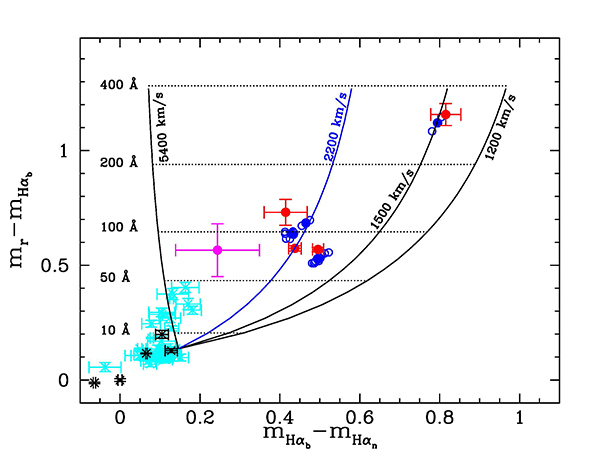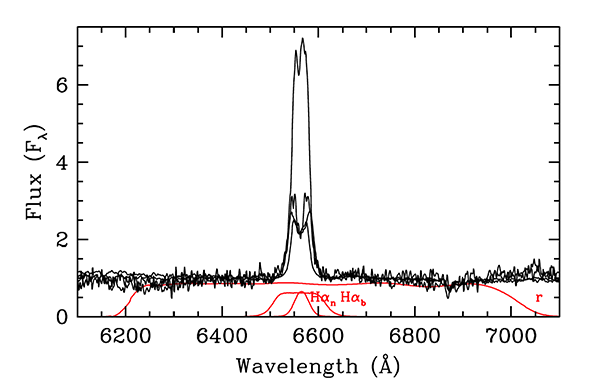ING web news release
19 October, 2018
A Feasibility Study on the Photometric Detection of Quiescent Black Hole X-ray Binaries
Black hole X-ray binaries (BHXBs) are essential to our understanding of extreme physics across the universe, such as accretion/ejection processes, supernova explosions, long gamma-ray bursts and gravitational-wave sources. About 60 BHXBs have been discovered to date in the Galaxy through transient outbursts but, unfortunately, only 17 are confirmed dynamically (i.e. have a mass function greater than ~3 solar masses), owing to difficulties in measuring the spectrum of the companion star at very faint quiescent luminosities.
Our knowledge of the fundamental parameters of BHXBs and thus of their formation and evolution as a population, is clearly jeopardized by limited statistics. Therefore, there is pressing need for new strategies to discover the hidden population of quiescent BHXBs.
Jorge Casares and Manuel A.P. Torres from the Instituto de Astrofísica de Canarias (IAC) have tested a novel photometric technique that can help unveil new quiescent BHXBs to unprecedented depths. They used an allocation of (IAC) Director's Discretionary Time with the instrument ACAM on the William Herschel Telescope (WHT), equipped with an OASIS r-band filter MR661 and two Halpha filters, kindly loaned by the Nordic Optical Telescope (NOT), to observe four dynamical BHXBs.
This filter combination allowed them to place the observed BHXBs in a colour-colour diagram. They appear conveniently detached from the locus occupied by normal field stars. Furthermore, their colours contain information on the equivalent width (EW) and full-width-at-half-maximum (FWHM) of the Halpha emission line, formed in the accretion disc around the black hole.
|
 |
Colour-colour diagram produced with the r-band MR661 filter and the two Halpha NOT filters. Black and cyan crosses on the left represent standard stars and field stars respectively. Red and blue circles indicate photometric and spectroscopic (synthetic) colours for the 4 BHXBs. The magenta circle depicts a test observation (i.e. short integration time) of another BHXB, without simultaneous spectroscopy. Lines of constant EW in the range 10-400 Å and constant FWHM betwteen 1200-5400 km/s are overploted for reference. Credit: J. Casares and M.A.P. Torres. Large format: [ JPEG ].
|
The photometric FWHM determinations were compared with spectroscopic FWHM values measured from near-simultaneous spectra, obtained with the instrument OSIRIS on the Gran Telescopio Canarias (GTC) using (IAC) Director's Discretionary Time. The results agree within 10%, thus proving that the FWHM of the Halpha lines in BHXBs can be recovered using photometric techniques.
|
 |
GTC spectra of the 4 BHXBs, obtained simultaneously with the WHT observations. The transmission curves of the r-band and Halpha filters are plotted in red.
Credit: J. Casares and M.A.P. Torres. Large format: [ PNG ].
|
This research opens the door to efficient selection of BHXBs since very deep gravitational wells are required to produce Halpha lines broader than FWHM > 2200 km/s.
Monte Carlo simulations have shown that a cut-off at FWHM > 2200 km/s would allow selection of half of the BHXBs while rejecting other (dominant) populations of Halpha sources.
It is estimated that a survey of ~1000 square degrees of the Galactic plane at signal-to-noise-ratio SNR~50 and depth r~22, using this filter strategy, would unveil around 50 new BHXBs, a three-fold improvement over the current population. Such a survey would also provide a detailed census of other Galactic populations of interest, most notably short-period (eclipsing) cataclysmic variables, neutron star X-ray binaries and ultra-compact binaries.
More information:
J. Casares, M.A.P. Torres, 2018, "A feasibility study on the photometric detection of quiescent black hole X-ray binaries", MNRAS, 481, 4372 [ MNRAS | ADS ]
J. Casares, 2018, "Hibernating black holes revealed by photometric mass functions", MNRAS, 473, 5195 [ MNRAS | ADS ]
"Astronomers propose a new method for detecting black holes", IAC press release, 19 October 2018.
|
|



